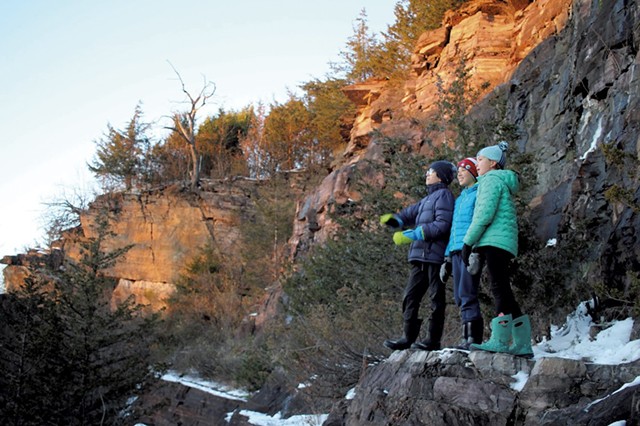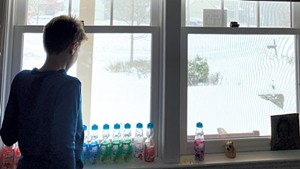
- Ben Wang
- Heather's son Jesse (center) and friends at Redstone Quarry in Burlington
It took me a long time to figure out what bedrock is. Though geologists don't seem to say it so simply, the definition I developed for myself in grad school is: it's the rock that's attached to the earth. Now, when I see interesting bedrock features like ledges and outcrops, I point them out to my 11-year-old son because I want him to grow up more in tune with his natural surroundings than I was. It can be hard, though, to extend the conversation beyond his monosyllabic response — "cool" — especially if we can't climb on the feature I'm pointing out.
In order to make the concept of bedrock come to life, I designed a scavenger hunt to seek out a distinctive and attractive type of bedrock that stretches in a band through Addison and Chittenden counties. This type of bedrock, Monkton quartzite, is also known as redstone. Its typical reddish-purple color is the reason Red Rocks Park and the University of Vermont's Redstone Campus have their names.
My nongeologist understanding of this rock's story is this: Approximately 540 million years ago, the place that would become Vermont was submerged under a shallow tropical ocean, and sand was deposited along the shoreline. After a long time and a lot of heat and pressure, it became the kind of sandstone known as Monkton quartzite. The red color comes from iron-rich material that rusted around the sand grains. At some locations, where the internal layering is exposed under your feet, you can see ripples from long-ago waves, and tracks and burrows from little sea creatures.
From south to north, here are a few locations to find Monkton quartzite. Some of them are expeditions in their own right, while others are observable on your way to someplace else.
Charlotte Park and Wildlife Refuge, Greenbush Road: Note the pillars that frame the entrance! The stones in them likely did not travel very far to be there. Because it's a wildlife refuge, dogs are not allowed.
Mount Philo, Charlotte: The lower part of Mount Philo is made of shale, but up at the top, you will see Monkton quartzite. Because the Champlain thrust fault pushed older rocks on top of younger rocks 450 million years ago, the older quartzite is on top of the younger shale.
Shelburne Bay Park, Shelburne: There are some nice slabs jutting into the water along the Clarke Trail, along with at least one very nice stone wall made of Monkton quartzite.
Shelburne Road near Webster Road: Monkton quartzite is interspersed with orange dolostone along the roadcut blasted through the rock lining Shelburne Road. Layers of dolostone are often located between layers of Monkton quartzite (geologists call this the Monkton Formation). Learn more about why that is so at the Perkins Museum of Geology website, uvm.edu/perkins/educational-materials.
Red Rocks Park, South Burlington: The famous red cliffs along the lake are made of Monkton quartzite, as are the ledges and outcrops throughout.
Redstone Quarry, Hoover Street, Burlington: This hidden oasis, in the middle of a residential neighborhood, is the quarry from which much of the redstone you can see around Burlington (see below) was extracted. There is a parking pull-off for this UVM natural area on Redstone Terrace and parking along Hoover Street as well. You can see the dramatic quarry face and parts of the exposed quarry floor (complete with ripples), and you can climb on the rocks at the northern end of the natural area if you're so inclined.
Many buildings and countless foundations along Lake Champlain: As noted on a UVM natural areas website, "Redstone was a popular building material in Burlington in the 1800's not only for its remarkable appearance and durability, but also because it was readily available at a small quarry within the city limits." UVM's Redstone Campus is a notable example, with its redstone wall along South Prospect Street and some of its grand buildings, once part of the Buell estate. But once I started looking for redstone, I could not stop seeing it everywhere. In just one block in downtown Burlington, I noticed it in the foundation of the old part of the Fletcher Free Library (next to the fire station), the building between Memorial Auditorium and the boarded up motel, and in the College Street Congregational Church.
Salmon Hole, Burlington: This was one of my son's favorite sites as a toddler. There is a lot of rock to explore and clamber around on. Like Redstone Quarry, this is another site where you can see ripple marks and worm burrows.
The roadcuts blasted through the rocks between Exits 16 and 17 on Interstate 89: Layers of the purple Monkton quartzite and orange or buff-colored dolostone of the Monkton Formation are exposed.
I'm sure there are countless other examples of Monkton quartzite. But be prepared: If you put your kids on the hunt, I'm willing to bet they will put your observation skills to shame, and win your scavenger hunt by a landslide.











Comments
Comments are closed.
From 2014-2020, Seven Days allowed readers to comment on all stories posted on our website. While we've appreciated the suggestions and insights, right now Seven Days is prioritizing our core mission — producing high-quality, responsible local journalism — over moderating online debates between readers.
To criticize, correct or praise our reporting, please send us a letter to the editor or send us a tip. We’ll check it out and report the results.
Online comments may return when we have better tech tools for managing them. Thanks for reading.